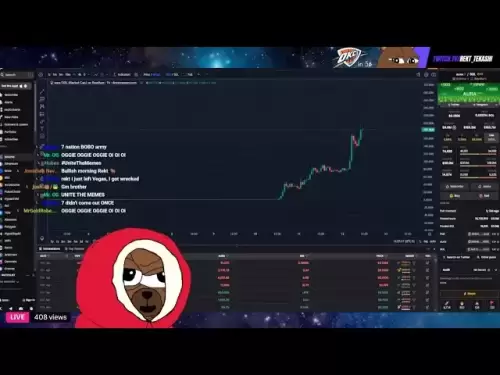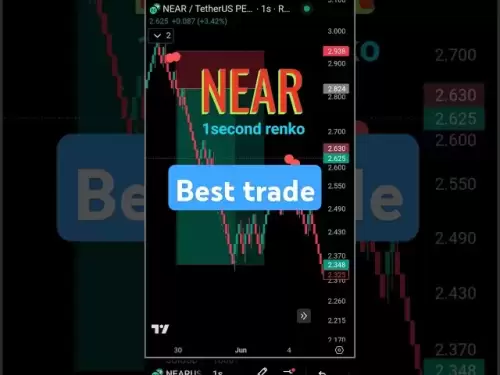-
 Bitcoin
Bitcoin $105,288.6945
-2.61% -
 Ethereum
Ethereum $2,546.9059
-7.84% -
 Tether USDt
Tether USDt $1.0004
0.05% -
 XRP
XRP $2.1438
-4.68% -
 BNB
BNB $653.2251
-1.80% -
 Solana
Solana $146.3449
-8.07% -
 USDC
USDC $0.9997
0.01% -
 Dogecoin
Dogecoin $0.1778
-5.94% -
 TRON
TRON $0.2688
-2.27% -
 Cardano
Cardano $0.6373
-7.04% -
 Hyperliquid
Hyperliquid $41.2776
-4.37% -
 Sui
Sui $3.0223
-9.71% -
 Chainlink
Chainlink $13.3280
-7.77% -
 Bitcoin Cash
Bitcoin Cash $430.6921
-2.12% -
 UNUS SED LEO
UNUS SED LEO $9.0426
1.98% -
 Avalanche
Avalanche $19.2275
-8.92% -
 Stellar
Stellar $0.2600
-5.55% -
 Toncoin
Toncoin $2.9984
-6.13% -
 Shiba Inu
Shiba Inu $0.0...01195
-5.71% -
 Hedera
Hedera $0.1566
-7.37% -
 Litecoin
Litecoin $84.6896
-5.28% -
 Polkadot
Polkadot $3.8188
-6.28% -
 Ethena USDe
Ethena USDe $1.0004
0.00% -
 Monero
Monero $311.9801
-3.66% -
 Dai
Dai $0.9998
0.00% -
 Bitget Token
Bitget Token $4.5149
-4.09% -
 Uniswap
Uniswap $7.4602
-6.13% -
 Pepe
Pepe $0.0...01088
-11.16% -
 Aave
Aave $280.9076
-8.02% -
 Pi
Pi $0.5699
-8.88%
Should I reduce my position when the RSI top diverges?
Reduce position size when RSI shows top divergence to manage risk proactively, protecting profits while staying exposed to market movements.
Jun 12, 2025 at 12:07 am
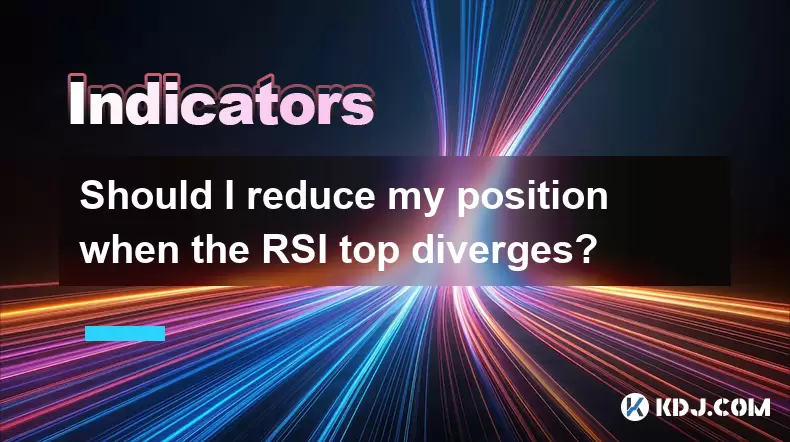
Understanding RSI and Divergence
The Relative Strength Index (RSI) is a momentum oscillator used in technical analysis to measure the speed and change of price movements. It ranges from 0 to 100 and is typically used to identify overbought or oversold conditions in a market. An RSI value above 70 indicates that an asset may be overbought, while a value below 30 suggests it may be oversold.
Divergence occurs when the price of an asset moves in the opposite direction of a technical indicator, such as the RSI. Top divergence, also known as bearish divergence, happens when the price of an asset reaches a higher high while the RSI fails to reach a new high. This suggests that the momentum behind the price increase is waning, and a potential reversal may be imminent.
The Importance of Reducing Position Sizes
Reducing position sizes, or scaling out of a trade, is a risk management strategy used to protect profits and minimize potential losses. When you reduce your position, you are essentially taking some of your profits off the table while still maintaining exposure to the market. This can be particularly useful in volatile markets or when technical indicators suggest a potential reversal.
By reducing your position size when the RSI shows top divergence, you are taking a proactive approach to managing risk. Instead of waiting for a confirmed reversal, you are acting based on early warning signs that the current trend may be losing steam.
Identifying RSI Top Divergence
To identify RSI top divergence, you need to follow these steps:
- Plot the RSI on your chart: Use a time frame that suits your trading style, such as daily or hourly charts.
- Identify the price highs: Look for instances where the price reaches a new high.
- Compare the RSI highs: Check if the RSI fails to reach a new high during the same period that the price reaches a new high.
- Confirm the divergence: Ensure that the RSI is showing lower highs while the price is showing higher highs.
Implementing Position Reduction
Once you have identified RSI top divergence, you can proceed with reducing your position size. Here's how you can do it:
- Determine your target reduction: Decide how much of your position you want to reduce. This could be a percentage of your total position or a specific number of units.
- Place a sell order: Execute a sell order for the amount you have decided to reduce. This can be done at the current market price or using a limit order at a specific price level.
- Monitor the remaining position: Keep an eye on the remaining position and be prepared to take further action based on subsequent price movements and technical indicators.
Examples of RSI Top Divergence in Cryptocurrency Markets
To illustrate how RSI top divergence can be applied in cryptocurrency markets, let's look at a few examples:
- Bitcoin (BTC): Suppose you have been holding a long position in Bitcoin, and you notice that the price has reached a new high, but the RSI has failed to do the same. This could be a signal to reduce your position size to protect your profits.
- Ethereum (ETH): If you are trading Ethereum and see that the price is making higher highs while the RSI is making lower highs, it may be prudent to scale out of your position to mitigate risk.
- Altcoins: The same principle applies to altcoins. For instance, if you are holding a position in a coin like Cardano (ADA) and you spot RSI top divergence, consider reducing your exposure to safeguard your gains.
Combining RSI Top Divergence with Other Indicators
While RSI top divergence can be a powerful signal on its own, it is often beneficial to use it in conjunction with other technical indicators to confirm your analysis. Some popular indicators to combine with RSI include:
- Moving Averages: Look for bearish crossovers, such as the 50-day moving average crossing below the 200-day moving average, to confirm potential reversals.
- MACD (Moving Average Convergence Divergence): If the MACD line crosses below the signal line while the RSI shows top divergence, it can strengthen the bearish case.
- Volume: A decrease in trading volume during the price highs can further validate the weakening momentum indicated by RSI top divergence.
Practical Considerations for Reducing Positions
When reducing your position based on RSI top divergence, it's important to consider the following practical aspects:
- Liquidity: Ensure that the market has enough liquidity to execute your sell order without significantly impacting the price.
- Transaction Costs: Be mindful of the transaction costs associated with reducing your position, as these can eat into your profits.
- Tax Implications: Depending on your jurisdiction, reducing your position may have tax implications. Consult with a tax professional to understand the potential impact.
Psychological Aspects of Position Reduction
Reducing a position based on technical indicators like RSI top divergence can also have psychological benefits. It helps traders stay disciplined and adhere to their trading plan. By acting on early warning signs, you are less likely to fall victim to emotional decision-making, such as holding onto a position too long in the hope of further gains.
Additionally, reducing your position size can provide peace of mind. Knowing that you have taken some profits off the table and reduced your exposure to potential losses can make it easier to manage the remaining position and stay focused on your overall trading strategy.
Frequently Asked Questions
Q: Can RSI top divergence be used for short-term trading?
A: Yes, RSI top divergence can be used for short-term trading, but it's important to use shorter time frames, such as hourly or 15-minute charts, to identify the divergence more accurately. Short-term traders should also be prepared for higher volatility and adjust their position sizes accordingly.
Q: Is RSI top divergence a reliable indicator on its own?
A: While RSI top divergence can be a strong signal, it is generally more reliable when used in conjunction with other technical indicators and market analysis. Relying solely on RSI top divergence without confirming signals from other indicators can lead to false positives.
Q: How often should I check for RSI top divergence?
A: The frequency of checking for RSI top divergence depends on your trading style. For day traders, checking every few hours may be necessary, while swing traders might check daily or weekly. Regular monitoring is crucial to catch divergence signals as early as possible.
Q: Can RSI top divergence be applied to all cryptocurrencies?
A: Yes, RSI top divergence can be applied to all cryptocurrencies, but the effectiveness may vary depending on the liquidity and volatility of the specific coin. More liquid and widely traded cryptocurrencies like Bitcoin and Ethereum may provide more reliable signals compared to less liquid altcoins.
Disclaimer:info@kdj.com
The information provided is not trading advice. kdj.com does not assume any responsibility for any investments made based on the information provided in this article. Cryptocurrencies are highly volatile and it is highly recommended that you invest with caution after thorough research!
If you believe that the content used on this website infringes your copyright, please contact us immediately (info@kdj.com) and we will delete it promptly.
- Bitwise CEO Predicts Bitcoin Holders Will Stop Selling Once Price Surpasses $130,000
- 2025-06-14 01:30:12
- Neo Pepe’s Revolution Begins
- 2025-06-14 01:30:12
- Aptos (APT) Token Unlock – June 12, 2025
- 2025-06-14 01:25:12
- Aptos (APT) Token Unlock – June 12, 2025
- 2025-06-14 01:25:12
- Ruvi AI Emerges as a Potential Rival to Cardano (ADA)
- 2025-06-14 01:20:12
- Market Capitalization Often Confuses Casual Investors, and Detractors Have Weaponized It Against Bullish XRP Price Predictions
- 2025-06-14 01:20:12
Related knowledge
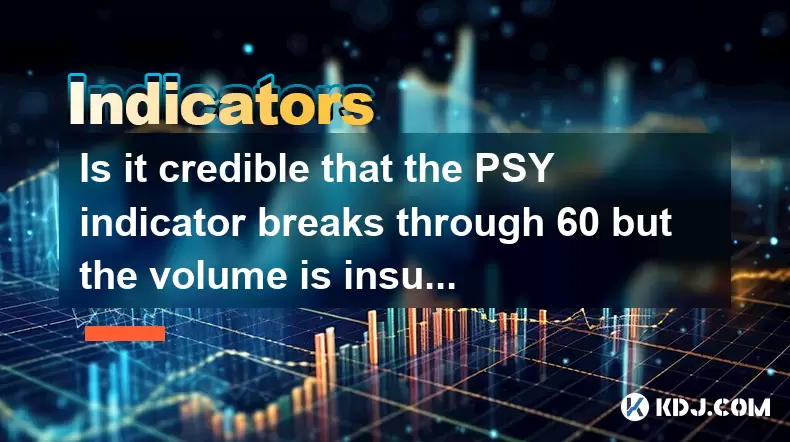
Is it credible that the PSY indicator breaks through 60 but the volume is insufficient?
Jun 14,2025 at 12:14am
Understanding the PSY Indicator in Cryptocurrency TradingThe Psychological Line (PSY) indicator is a momentum oscillator used primarily to measure the sentiment of traders and investors in financial markets, including the cryptocurrency space. It calculates the ratio of days where prices closed higher versus lower over a specified period, typically 12 o...
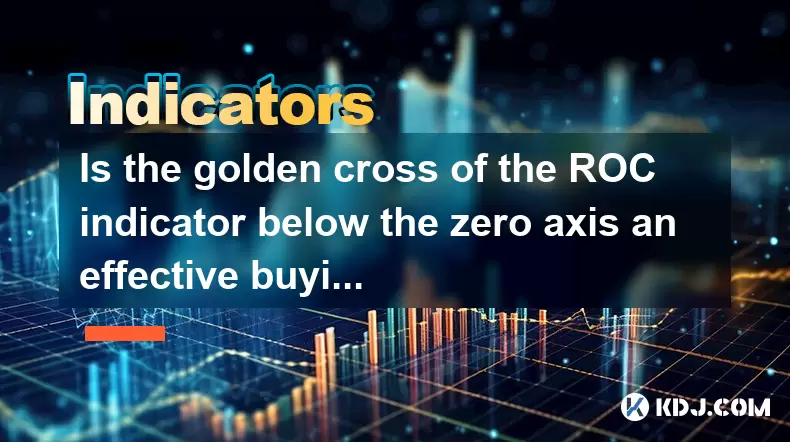
Is the golden cross of the ROC indicator below the zero axis an effective buying point?
Jun 14,2025 at 01:29am
Understanding the ROC Indicator and Its SignificanceThe Rate of Change (ROC) indicator is a momentum oscillator used in technical analysis to measure the percentage change in price between the current closing price and the closing price from a set number of periods ago. This tool helps traders assess the speed at which prices are changing, offering insi...

Will the RSI fall after the top divergence? How to improve the judgment accuracy?
Jun 13,2025 at 11:21pm
Understanding RSI and Top Divergence in Cryptocurrency TradingThe Relative Strength Index (RSI) is a momentum oscillator widely used in cryptocurrency trading to measure the speed and change of price movements. It typically ranges from 0 to 100, with levels above 70 considered overbought and below 30 considered oversold. In crypto markets, where volatil...
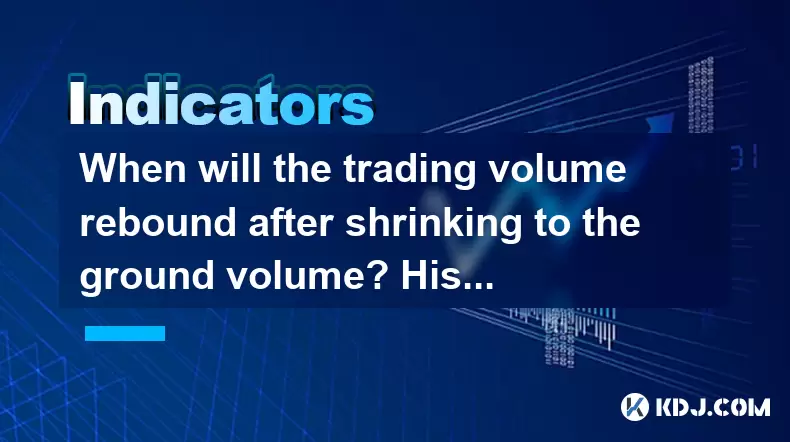
When will the trading volume rebound after shrinking to the ground volume? Historical percentile comparison method
Jun 13,2025 at 03:36pm
Understanding the Ground Volume Concept in Cryptocurrency MarketsIn cryptocurrency trading, 'ground volume' refers to a period when the trading volume of a particular asset or market drops significantly, often reaching multi-month or even multi-year lows. This phenomenon typically signals a lack of interest from traders and investors, suggesting that th...
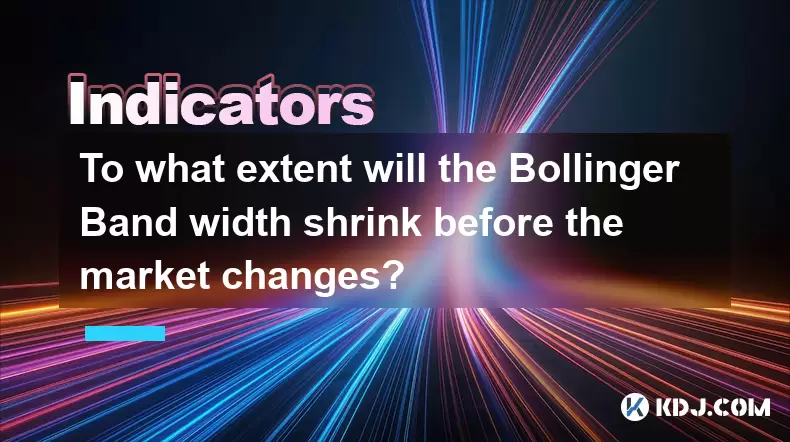
To what extent will the Bollinger Band width shrink before the market changes?
Jun 13,2025 at 06:35pm
Understanding the Bollinger Band Width and Its SignificanceThe Bollinger Band width is a critical technical analysis tool used in cryptocurrency trading to measure market volatility. It consists of three lines: a simple moving average (SMA), an upper band, and a lower band. The distance between the upper and lower bands reflects the level of volatility ...
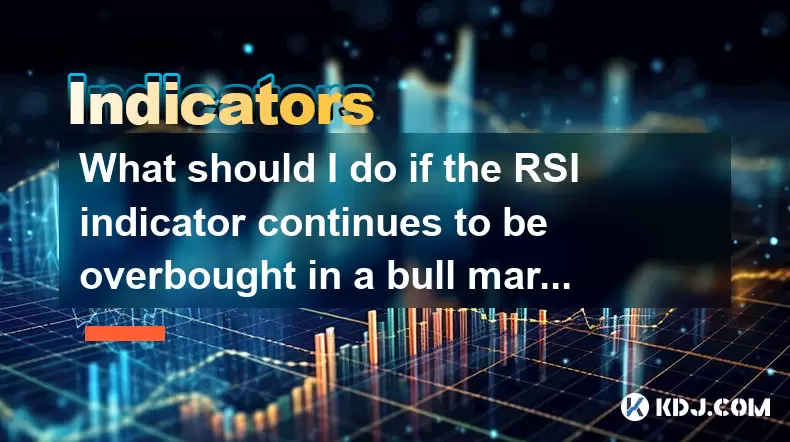
What should I do if the RSI indicator continues to be overbought in a bull market? How to adjust the overbought zone threshold?
Jun 13,2025 at 05:57pm
Understanding the RSI Indicator in a Bull MarketThe Relative Strength Index (RSI) is a momentum oscillator commonly used by traders to assess overbought or oversold conditions of an asset. In a bull market, especially within the cryptocurrency space, prices can remain elevated for extended periods. This often leads to the RSI indicator staying in the ov...

Is it credible that the PSY indicator breaks through 60 but the volume is insufficient?
Jun 14,2025 at 12:14am
Understanding the PSY Indicator in Cryptocurrency TradingThe Psychological Line (PSY) indicator is a momentum oscillator used primarily to measure the sentiment of traders and investors in financial markets, including the cryptocurrency space. It calculates the ratio of days where prices closed higher versus lower over a specified period, typically 12 o...

Is the golden cross of the ROC indicator below the zero axis an effective buying point?
Jun 14,2025 at 01:29am
Understanding the ROC Indicator and Its SignificanceThe Rate of Change (ROC) indicator is a momentum oscillator used in technical analysis to measure the percentage change in price between the current closing price and the closing price from a set number of periods ago. This tool helps traders assess the speed at which prices are changing, offering insi...

Will the RSI fall after the top divergence? How to improve the judgment accuracy?
Jun 13,2025 at 11:21pm
Understanding RSI and Top Divergence in Cryptocurrency TradingThe Relative Strength Index (RSI) is a momentum oscillator widely used in cryptocurrency trading to measure the speed and change of price movements. It typically ranges from 0 to 100, with levels above 70 considered overbought and below 30 considered oversold. In crypto markets, where volatil...

When will the trading volume rebound after shrinking to the ground volume? Historical percentile comparison method
Jun 13,2025 at 03:36pm
Understanding the Ground Volume Concept in Cryptocurrency MarketsIn cryptocurrency trading, 'ground volume' refers to a period when the trading volume of a particular asset or market drops significantly, often reaching multi-month or even multi-year lows. This phenomenon typically signals a lack of interest from traders and investors, suggesting that th...

To what extent will the Bollinger Band width shrink before the market changes?
Jun 13,2025 at 06:35pm
Understanding the Bollinger Band Width and Its SignificanceThe Bollinger Band width is a critical technical analysis tool used in cryptocurrency trading to measure market volatility. It consists of three lines: a simple moving average (SMA), an upper band, and a lower band. The distance between the upper and lower bands reflects the level of volatility ...

What should I do if the RSI indicator continues to be overbought in a bull market? How to adjust the overbought zone threshold?
Jun 13,2025 at 05:57pm
Understanding the RSI Indicator in a Bull MarketThe Relative Strength Index (RSI) is a momentum oscillator commonly used by traders to assess overbought or oversold conditions of an asset. In a bull market, especially within the cryptocurrency space, prices can remain elevated for extended periods. This often leads to the RSI indicator staying in the ov...
See all articles





















